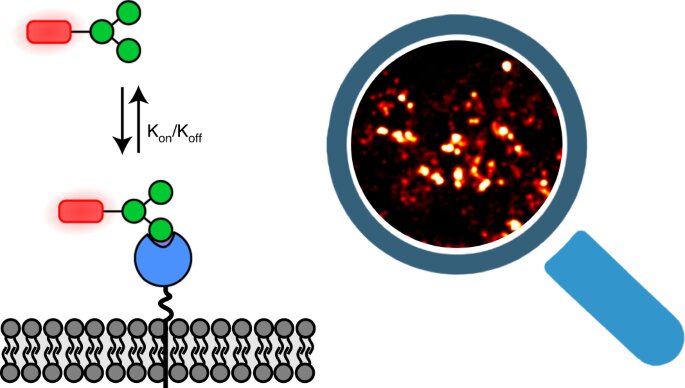
Unraveling the interactions of individual sugar molecules with cells
Sugars interact with the cell surface through sugar-binding proteins called lectins. These interactions play a fundamental role in many of the cell's biological processes. One important function is the modulation of the immune response towards an outside threat. In a recent Nature Chemical Biology paper, ICMS researchers team up with researchers from Leiden University to unravel the interactions of individual sugar molecules with cells using super-resolution microscopy.Ph.D. candidate Roger Riera, from the Nanoscopy for Nanomedicine group at Biomedical Engineering, investigates cell surface receptors and their interaction with molecules using novel microscopy techniques. The idea to image sugar-lectin interactions started from a long ongoing collaboration with Leiden University researchers. "We bring together two fields: our collaborators develop sugar probes and we have the microscopy expertise," says Riera.Imaging one sugar at a time"Our concept was to use the same sugars that interact with cells as microscopy probes," explains Lorenzo Albertazzi, associate professor and leader of the Nanoscopy for Nanomedicine group. "We didn't need to change the building blocks."The interaction of sugars with cells is weak, making it challenging to study with conventional fluorescence techniques. "We actually need weak interactions for our microscopy method," says Riera. "It's a perfect match. The imaging is based on reversible interactions: fluorescently labeled sugar probes bind for a very short time to the cell's lectins and unbind. This process is repeated over time, enabling the detection of individual sugar-lectin interactions." Interesting properties surfaced from this study. "We could see that different sugar structures present different binding kinetics, bringing us closer to understanding their structure-activity relationship."The sugar SOS codeIn some cases, sugars can signal danger and provoke an immune activation. This signaling happens when the body recognizes the sugars from a pathogen's membrane. "Immune cells recognize the difference between our native sugars and the ones from a pathogen by recognizing the sugar patterns," says Riera. "These patterns depend on the sugar arrangement."Are sugars a candidate to develop more potent vaccines? "We can use sugars to trick the immune system into thinking it's a danger signal and stimulate an immune response, similar as in vaccines," he explains. However, there is a sweet spot to get it exactly right. "If you use the wrong sugars, the immune response will be very different," says Albertazzi. But more research is needed. "Our methods could be used to understand better how immune cells recognize certain sugars over others."More information:Roger Riera et al, Single-molecule imaging of glycanlectin interactions on cells with Glyco-PAINT, Nature Chemical Biology (2021). DOI: 10.1038/s41589-021-00896-2Citation: Unraveling the interactions of individual sugar molecules with cells (2021, November 23) retrieved 23 November 2021 from https://phys.org/news/2021-11-unraveling-interactions-individual-sugar-molecules.htmlThis document is subject to copyright. Apart from any fair dealing for the purpose of private study or research, no part may be reproduced without the written permission. The content is provided for information purposes only.
……
Comments
Leave a comment in Nestia App